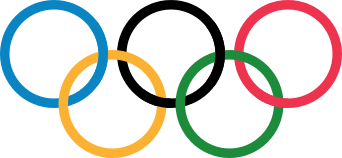 It’s just one year until the start of the Games of the XXXI Olympiad in Rio de Janeiro, so, I decided we should take a look at the Olympic Flag, one of the most recognisable symbols in the world.
It’s just one year until the start of the Games of the XXXI Olympiad in Rio de Janeiro, so, I decided we should take a look at the Olympic Flag, one of the most recognisable symbols in the world.
The flag’s ring design was created by the founder of the modern Olympics himself, Baron Pierre de Coubertin in 1912. The Baron said of his design: “The six colours (white, blue, yellow, black, green and red) thus combined reproduce the colours of all the nations, with no exceptions. Here is an international symbol. ”
The rings have had a separate interpretation besides the meaning de Coubertin gave. Prior to 1951 the official Olympic handbook stated each ring represented a continent: blue for Europe, yellow for Asia, Black for Africa, Green for Oceania and red for the Americas. This was removed due to lack of evidence that this was the intention.
Two years after the ring’s design, the Olympic Flag was officially presented by de Coubertin at the 1914 Olympic Congress in Paris. The International Olympic Committee (I.O.C.) was given a flag by the Belgian city of Antwerp when it hosted the 1920 Olympics. At the end of the games a new flag was made for the 1924 Paris Olympics, but the flag was still know as the Antwerp Flag. This flag was retired at the 1988 Olympics in Seoul, South Korea. The Seoul Flag is currently used in the Antwerp Ceremony, which takes place during each closing ceremony – it’s the official handover of the Olympic Flag between the mayor of the current host city and the mayor of the next.
Unveiled at the 1952 Winter Olympics, the Oslo Flag is still used for the Winter Olympics, while the Singapore Flag first appeared during the closing ceremony of the inaugural Youth Olympics in 2010.
Flag in a suitcase
The whereabouts of the original Antwerp Flag was a mystery for 77 years.
At a 1997 US Olympic Committee banquet a reporter mentioned to his interviewee, 1920 men’s 10m Platform Diving bronze medallist Hal Haig ‘Harry’ Prieste, that the I.O.C. hadn’t been able to find the 1920 Antwerp Flag.
“I can help you with that. It’s in my suitcase.” Replied Prieste, who after being spurred on by team-mate (and double Olympic Swimming Champion) Duke Kahanamoku, climbed the flagpole and simply stole the flag.
For the next 80 years it resided in Prieste’s suitcase.Prieste returned the flag to the I.O.C. in a special ceremony at the 2000 Sydney Olympics, aged 103. In return he was given a commemorative medal, but passed away the following April.
The Antwerp Flag is now on display in the Olympic museum in Lausanne, Switzerland. A plaque thanks Prieste for his donation.
Alex Crouch is a 2014 journalism graduate from Southampton Solent University. He has followed Formula One since before he started infant school, was a Games Maker during the London Paralympics and saw Pink Floyd reunite for one song at The O2 in London. Links: Twitter, blog, YouTube. Alex is an accredited Flag Institute journalist.
![Haig_Prieste_with_Olympic_flag[1]](https://www.flaginstitute.org/wp/wp-content/uploads/2015/08/Haig_Prieste_with_Olympic_flag1-300x180.jpg)

